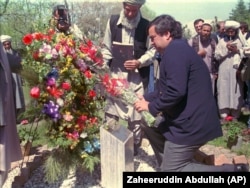On February 14, 1979, Adolph Dubs, the U.S. ambassador to Afghanistan, was kidnapped at gunpoint, held hostage in a Kabul hotel, and killed in a botched rescue attempt.
Forty years on, the precise circumstances surrounding the death of the 58-year-old diplomat remain shrouded in mystery. Several questions remain unanswered, including who was behind Dubs' kidnapping, who fired the fatal shots, and whether the Soviet Union was involved.
The death of Dubs, a former charge d'affaires in Moscow, came at a critical time during the Cold War -- it was a year after communists seized power in Kabul and months before the Soviet Union sent in troops to prop up the Marxist government.
Author Anthony Arnold suggested that "it was obvious that only one power...would benefit from the murder -- the Soviet Union."
The incident prompted international shock and outraged the administration of U.S. President Jimmy Carter, which closed the U.S. Embassy in response, although it did keep a charge d'affaires. Months later, Washington began its covert support to the mujahedin, the Islamist guerrilla fighters who were battling the Kabul regime and would later fight the Soviet Army.
Room 117
On the morning of February 14, Dubs' car was stopped by four gunmen in Kabul as he was traveling to the U.S. Embassy. There were reports that at least one of the gunmen was dressed as a uniformed Kabul traffic policeman. Dubs' abductors took him downtown to the Hotel Kabul, now known as the Serena Hotel.
By noon, Afghan security forces had surrounded the hotel. Soon after, Afghan forces stormed Room 117, where Dubs was being held. After a brief exchange of fire, Dubs was found dead. The ambassador had suffered multiple gunshot wounds to his head and chest.
Two of the four gunmen involved in Dubs' abduction were also killed in the assault.
'Suppression Of The Truth'
Washington protested to Kabul, saying that Afghan forces stormed the building despite a warning from the U.S. Embassy "in the strongest possible terms" not to attack the hotel or open fire on the kidnappers while attempts were being made to negotiate Dubs' release.
In 1980, the State Department issued a report on its yearlong investigation into Dubs' death, attributing blame to Afghan authorities and Soviet advisers assisting them.
The State Department said that at least three Soviet advisers had played an "operational role" during the storming of the hotel.
Moscow acknowledged that its advisers were present but said they had no control over the Afghan decision to storm the hotel room. Kabul said Soviet advisers were not present.
Washington said it was also not able to reach Foreign Minister Hafizullah Amin for hours, a claim denied by Amin, who would later become the leader of the country.
The State Department report said Dubs died of "at least 10 wounds inflicted by small-caliber weapons."
The report said physical evidence in the hotel room, including weapons, had disappeared.
Afghan officials produced for the Americans the body of a third kidnapper who had been detained by police. Kabul also provided the corpse of the fourth kidnapper, who U.S. officials did not see at the hotel.
It is still unknown whether Dubs was killed by his abductors, his would-be rescuers, or a combination of both.
The State Department said the Kabul government's account was "incomplete, misleading, and inaccurate," with "no mention of the Soviets involved in the incident." The U.S. report concluded: "Sufficient evidence has been obtained to establish serious misrepresentation or suppression of the truth by the government."
Cold Case
The identities of Dubs' kidnappers were never revealed, and Washington, Moscow, and Kabul all have their own take on the incident.
Carter's national-security adviser, Zbigniew Brzezinski, blamed Dubs' death on "Soviet ineptitude or collusion," according to his memoirs. He described the Afghan handling of the incident as "inept."
In the book Afghanistan: The Soviet Invasion In Perspective, author Anthony Arnold suggested that "it was obvious that only one power...would benefit from the murder -- the Soviet Union," as the death of the ambassador "irrevocably poisoned" the U.S.-Afghan relationship, "leaving the U.S.S.R. with a monopoly of great-power influence over" the Kabul government.
In the months after Dubs' death, Carter would dramatically draw down America's diplomatic presence in Afghanistan and cut off economic and humanitarian aid.
In Russia, the kidnapping was blamed on the CIA, which state media said wanted to provide an excuse for U.S. military intervention in Afghanistan.
Kabul claimed the abductors were members of a small Maoist group, while officials at the time also blamed the mujahedin.
The abductors had demanded the release of "religious figures" who they said were being held by the Kabul government.
In a newly published book, Afghanistan: A History From 1260 To The Present, author Jonathan Lee writes that U.S. officials suspected the communist government in Kabul was behind the incident "either in a naïve attempt to discredit the Islamist resistance or to force the U.S.A. and NATO powers to disengage with Afghanistan."









